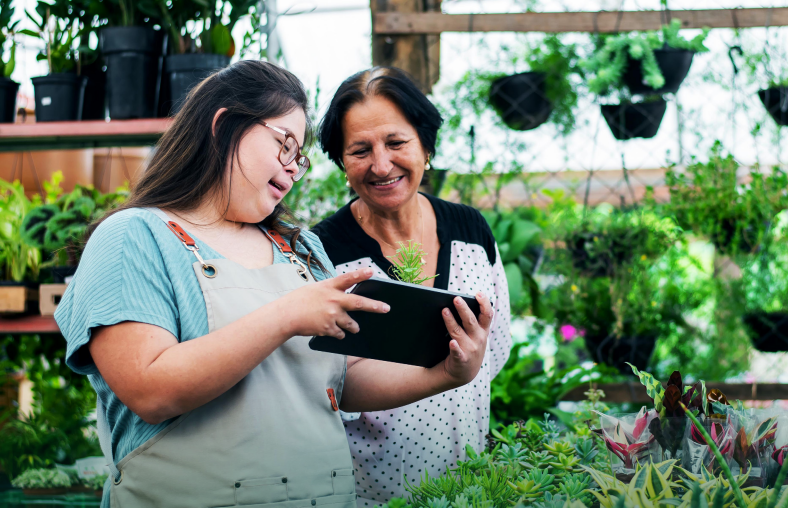For individuals living with intellectual and developmental disabilities (IDD), achieving a sense of community and belonging can be difficult. They face stigma and barriers to success on both inter-personal and systemic levels. Due to these obstacles, organizations must find ways to support community inclusion for their clients.
In this article, we’ll cover what community inclusion is, the most common barriers to it, and how your organization can help clients with IDD become better integrated into their own communities.
What is community inclusion?
Community inclusion among IDD providers refers to services that help persons served integrate with and be valued by their community for their unique abilities and perspectives. This can encompass finding and maintaining employment, social and familiar relationships, and participating in their community’s civic life.
Community inclusion provides a road map to socialization for those with IDD by creating an environment that facilitates individual well-being and a sense of connectedness and worth. Individuals living with IDD and other disabilities can find it hard to connect with their peers or wider community, as research suggests that they frequently feel cut off. As a result of this isolation, individuals with IDD are more likely to experience loneliness.
This is why community inclusion practices are so critical. Community inclusion, or the opportunity to live like everyone else, results in community presence, participation, and increased well-being.
But how can you get started? We suggest following the following principles of community inclusion:
- Choice: Include persons served in each step of the process, allowing them to exercise self-determination based upon personal preference.
- Responsibility: Aid persons served in their efforts to grow from trying new things, learning from mistakes, and trying again.
- Cultural compatibility: Each individual will have preferences based on world view, values, and roles. Respect these cultural norms and work to promote community inclusion in a way that adheres to them.
- Natural supports: These are the various types of relationships that are typically present in a person’s life, such as familial, professional, neighborly, and casual social relationships. For those with IDD, however, these relationships can be difficult to maintain. For those supporting individuals with IDD, it’s important to help them find and nurture natural supports.
Including these elements in your community inclusion program will help create both a sense of autonomy and connection to community for persons served.
The 5 “A” barriers to community inclusion
As with all initiatives in human services, your efforts to improve community inclusion for your clients will face some obstacles. While this is frustrating, these obstacles are well-known and documented, allowing you to make a plan to avoid them.
The five main barriers to community inclusion are:
- Affordability. Individuals with IDD have a much lower employment rate than those without a disability, and often live in poverty. This makes accessing public goods and services even more difficult.
- Accessibility. The availability and convenience of public transportation is necessary for most clients to have access to activities and services in the community. Despite passage of the Americans with Disabilities Act in 1990, many physical spaces and programs remain inaccessible to people with IDD. For example, a program may be held in a building that is not accessible to someone using a wheelchair.
- Applicability. Ultimately, an activity or service will only be relevant to your client if it is consistent with their needs, interests, and culture.
- Availability. Some communities offer little to no resources that promote community integration, or resources may be available at times that are not workable for your client.
- Awareness. One aspect of the IDD provider’s role is to network within the community, building both a knowledge base and relationships to enhance their work with individuals. In turn, organizations need to make sure their information is available online, public bulletin boards, and in free community papers.
Now that we know the common barriers to community inclusion, let’s explore what your organization can do to better promote inclusion for your people with IDD.
Best practices for promoting community inclusion
The role of direct support and other IDD professionals in promoting community inclusion requires different approaches than traditionally practiced.
One role is to be knowledgeable of the social context of the person being supported and to facilitate relationships between the individual (or family) and the community.
Some ways that your organization can assist individuals with IDD in expanding their social roles in the community include:
- Helping to mend broken familial and working relationships, as well as friendships.
- Assisting in establishing new relationships, by assessing interests and abilities and facilitating your clients’ inclusion in groups that share these interests. These can include hobbyist groups, jobs that match your clients’ abilities, and more.
An equally important task is to help enhance a community’s capacity to welcome and support its members by addressing issues of stigma and discrimination. To that end, programs and practitioners must work both within their communities to address ableism but also look within the organization to ensure that any ableist practices are changed. Providing training on the rights of people with IDD both to the staff at your organization and to the individuals themselves is one way to address this barrier.

Direct Support Professional Career Growth
Relias can help you increase DSP engagement and retention by partnering together to offer them meaningful career growth opportunities.
Learn more →





